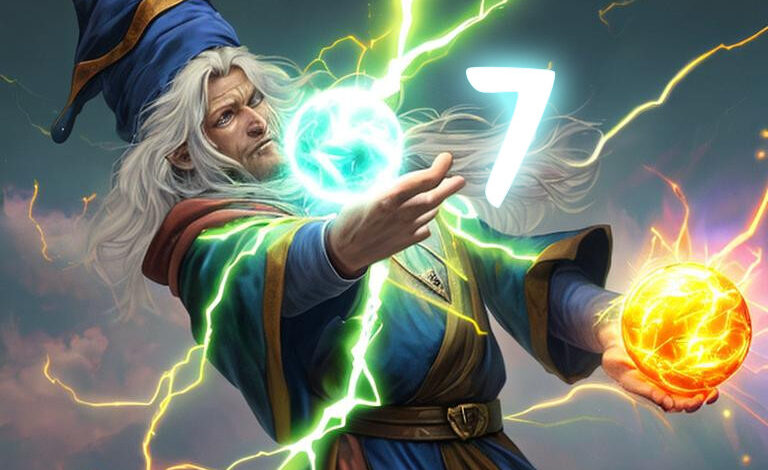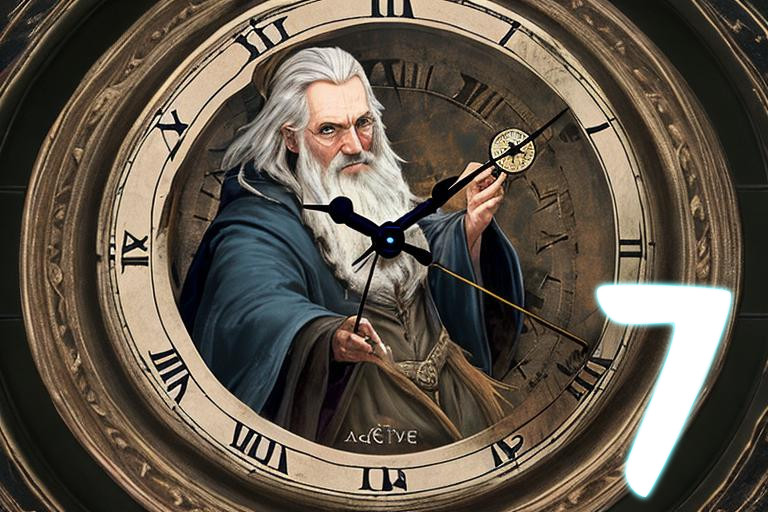
Throughout the annals of time, numbers have held an undeniable allure for humanity, transcending their mere mathematical significance to become powerful symbols woven into the fabric of human consciousness. Among these numbers, none possess a more mysterious and profound appeal than the enigmatic number 7. Across diverse cultures and spiritual traditions, the number 7 has emerged as a symbol of profound significance, encapsulating a plethora of spiritual and mystical associations.
From the sacred texts of ancient civilizations to modern-day beliefs, the number 7 has left an indelible mark on human history and cultural heritage. Its omnipresence in religious doctrines, celestial phenomena, and even fundamental aspects of our daily lives has beckoned generations to explore its deeper meanings and hidden truths.
In the sacred scriptures of Christianity and Judaism, the divine creation of the world is described to have occurred over seven days, with each day representing a phase of God’s creative process. This narrative of completion and perfection within seven days has laid the foundation for the seven-day week, an enduring cultural and temporal construct that shapes the lives of billions worldwide.
Beyond the sacred texts, the number 7 has also taken on symbolic significance in the realm of spirituality and morality. Christianity’s Seven Deadly Sins represent a classification of vices that threaten the very essence of the soul, while various Eastern spiritual traditions associate the number with the body’s seven chakras, believed to be gateways to spiritual energy and self-realization.
Stepping outside the realm of religious beliefs, the number 7 reveals its celestial presence. Ancient civilizations gazed at the night sky, identifying seven luminous objects visible to the naked eye – the Sun, the Moon, and five planets. These celestial entities, each with their unique attributes, became inextricably linked to the days of the week, bestowing an astral identity to the concept of time itself.
Moreover, the world of numerology has bestowed upon the number 7 an aura of intrigue and enigma. Regarded as a number of mystery and introspection, those born with a life path number of 7 are believed to be seekers of truth and wisdom, drawn to explore life’s mysteries in their quest for spiritual growth.
The allure of the number 7 is not confined to the realms of spirituality alone; it permeates diverse fields of human endeavor. Ancient wonders like the Seven Wonders of the Ancient World and the Seven Hills of Rome stand testament to the human inclination to attach significance to this mysterious numeral.
In this exploration of the number 7, we embark on a journey that traverses time, culture, and belief systems. Delving into its manifold manifestations, we seek to unravel the profound secrets that lie beneath its seemingly simple facade. As we peel back the layers of symbolism, mystery, and significance, we uncover the deeper meanings that have shaped human perception and the very foundation of our civilizations.
Join us as we unravel the mystical tapestry of the number 7 and discover the profound secrets it has guarded throughout the ages, offering us glimpses into the boundless depths of human spirituality and the universal mysteries that continue to captivate our imaginations.
Unveiling the Secrets of Number 7

Astronomical Observations:
Ancient civilizations, including the Babylonians and Egyptians, were keen observers of the celestial world. They noticed that there were seven luminous objects visible to the naked eye in the sky – the Sun, the Moon, and five visible planets (Mercury, Venus, Mars, Jupiter, and Saturn). These celestial bodies became associated with the days of the week and were often linked to different deities or divine forces, lending importance to the number 7.
Divine Creation: The Seven Days of Genesis
In many religious traditions, the number 7 symbolizes completeness and perfection. Perhaps the most well-known association is with the Judeo-Christian creation story, where God is said to have created the world in seven days. Each day marked a phase of creation, culminating in the seventh day when God rested. This notion of a seven-day week persists to this day and remains an integral part of various calendars worldwide.
The Seven Deadly Sins: Battling Temptation
In Christianity, the concept of the Seven Deadly Sins represents a classification of vices that threaten the spiritual wellbeing of individuals. These sins include wrath, greed, sloth, pride, lust, envy, and gluttony. By acknowledging and overcoming these vices, believers aim to purify their souls and attain spiritual growth.
The Days of the Week: A Celestial Influence
The seven-day week, as we know it today, can be traced back to ancient civilizations like Mesopotamia and Rome, where each day was associated with a celestial body or deity. Sunday (Sun’s day), Monday (Moon’s day), Tuesday (Tiw’s day), Wednesday (Woden’s day), Thursday (Thor’s day), Friday (Freya’s day), and Saturday (Saturn’s day) reflect the cosmic influence on daily life.
The Seven Chakras: Aligning Spiritual Energy
In various Eastern spiritual traditions, the human body is believed to be the vessel of spiritual energy. The chakras, which are energy centers along the body’s spine, play a crucial role in this philosophy. There are seven main chakras, each representing different aspects of human existence and consciousness. When these chakras are balanced and aligned, it is believed to lead to spiritual harmony and well-being.
Numerology: Exploring Inner Traits
Numerology, the belief in a mystical relationship between numbers and events or characteristics, often attributes special qualities to the number 7. In numerology, 7 is associated with introspection, intuition, and spiritual awakening. People with a life path number of 7 are considered seekers of truth and wisdom, drawn to explore the mysteries of life.
The Seven Wonders of the Ancient World: Human Ingenuity
The Seven Wonders of the Ancient World, including the Great Pyramid of Giza, the Hanging Gardens of Babylon, and the Statue of Zeus at Olympia, were a testament to human creativity and architectural brilliance. These wonders captivated the ancient world and inspired awe and reverence, highlighting the mystical allure of the number 7 in historical achievements.
Lunar Phases: Cycles of Transformation
The lunar cycle, with its seven fundamental phases (New Moon, Waxing Crescent, First Quarter, Waxing Gibbous, Full Moon, Waning Gibbous, and Third Quarter), has been closely tied to spiritual and agricultural practices throughout human history. The Moon’s rhythmic dance through these phases represents cycles of transformation, renewal, and introspection.
Seven Directions:
In some witchcraft traditions, practitioners may work with the concept of the Seven Directions, which includes the four cardinal directions (North, South, East, and West) along with the three sacred directions (Above, Below, and Within). These directions represent different energies and spiritual aspects that witches can invoke and connect with during rituals and spellwork.
Seven Hermetic Principles:
Derived from the teachings of Hermeticism, an esoteric tradition, the Seven Hermetic Principles form the basis of understanding the universe’s underlying principles. These principles include Mentalism, Correspondence, Vibration, Polarity, Rhythm, Cause and Effect, and Gender. Witches may incorporate these principles into their magical practices and spiritual development.
Knots:
Knot magic is a form of spellcasting where knots are tied in a cord or string to seal intentions or bind energies. In some traditions, witches may use seven knots to lend additional power and significance to the spell, often accompanied by corresponding words or incantations for each knot.
Seven-Pointed Star:
The seven-pointed star, also known as the septagram or heptagram, is a symbol commonly used in witchcraft. Each point of the star represents one of the seven traditional planets (Sun, Moon, Mercury, Venus, Mars, Jupiter, and Saturn) and is associated with specific planetary energies used in rituals and spellwork.
Seven Herbs:
Some witchcraft traditions work with a specific set of seven herbs, often referred to as “the Seven Sacred Herbs” or “the Seven Witches’ Herbs.” These herbs, such as Mugwort, Lavender, Rosemary, Sage, Thyme, Yarrow, and Chamomile, are believed to possess potent magical properties and are commonly used in various rituals and herbal magic.
Seven Candles:
In candle magic, the use of seven candles is prevalent, particularly in rituals that span seven consecutive days or nights. Each candle may be anointed with oils, carved with specific symbols, or colored to represent different intentions or aspects of the spell or ritual.
Human Perception and Memory:
Research suggests that humans tend to find patterns in things, including numbers. The number 7 is often perceived as aesthetically pleasing and memorable due to its regularity and frequent occurrence in nature and everyday life. This natural appeal may have led to its pervasive use in cultural and spiritual symbolism.
Musical Scales:
In Western music, the diatonic scale consists of seven notes within an octave. This sequence of seven notes repeats in higher and lower octaves, forming the basis of melodies and harmonies in countless musical compositions.
Seven Ages of Man:
In William Shakespeare’s play “As You Like It,” the character Jacques famously speaks about the seven stages of human life, from infancy to old age, in the monologue “All the world’s a stage.”
Seven Liberal Arts:
In medieval education, the Seven Liberal Arts formed the foundation of a well-rounded education. The Trivium (Grammar, Rhetoric, and Logic) and the Quadrivium (Arithmetic, Geometry, Music, and Astronomy) comprised these seven arts.
Seven Colors of the Rainbow:
The visible spectrum of light consists of seven primary colors – red, orange, yellow, green, blue, indigo, and violet – forming the rainbow, a natural and captivating phenomenon.
Seven Continents and Seven Seas:
Traditionally, the world is divided into seven continents: Asia, Africa, North America, South America, Antarctica, Europe, and Australia. Additionally, ancient cultures recognized seven seas, which included the Mediterranean, Adriatic, and others.
Seven Sisters:
The Pleiades, also known as the Seven Sisters, is an open star cluster in the constellation of Taurus. This cluster has been a significant cultural and astronomical reference point for various civilizations throughout history.
Final Musings:
The number 7 has woven itself into the very fabric of human existence, from ancient creation myths to contemporary spiritual beliefs. Its significance extends beyond cultural boundaries, resonating with people worldwide as a symbol of completion, perfection, and spiritual enlightenment. Whether through religious texts, mystical practices, or ancient wonders, the secrets of the number 7 continue to inspire and captivate the human spirit, inviting us to delve deeper into the profound mysteries of existence.




